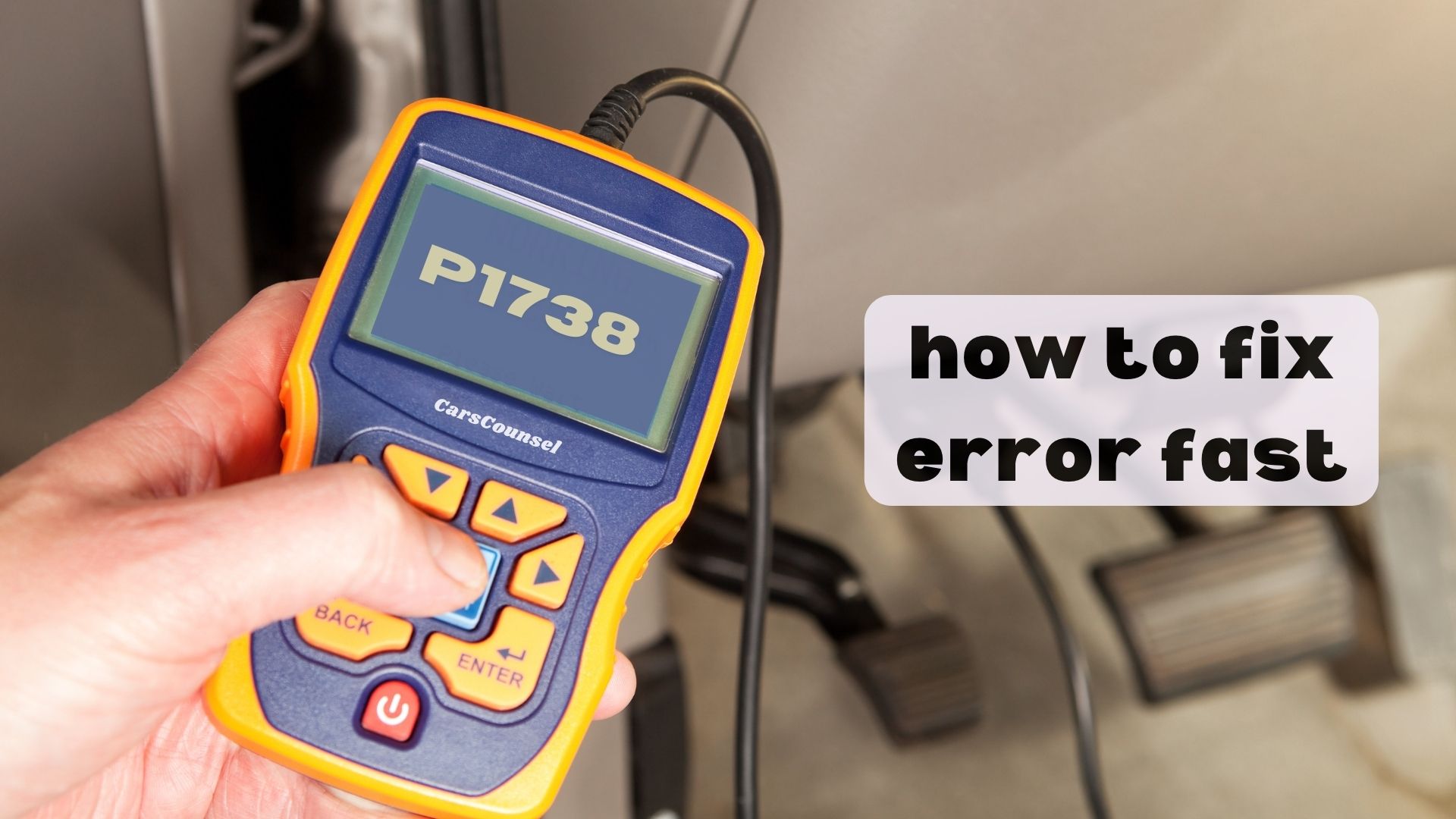You’re driving down the highway when your transmission starts acting up, and the check engine light comes on. You plug in your code reader and see P1738 staring back at you. This code indicates a problem with the 2nd Clutch Pressure Switch Circuit, but what does that even mean? It could be a faulty switch, electrical issues, or even a malfunctioning Powertrain Control Module. Whatever the cause, you know you need to get to the bottom of it before your transmission takes a hit.

Quick Navigation
Key Takeaways
- The P1738 code indicates a problem in the 2nd Clutch Pressure Switch Circuit, typically triggered by an issue detected in the transmission circuit.
- Common causes include a faulty 2nd Clutch Pressure Switch, electrical issues, or a malfunctioning Powertrain Control Module (PCM).
- Symptoms may include harsh shifting, delayed shifting, or transmission slippage, accompanied by the illumination of the Engine Light or Service Engine Soon Warning Light.
- To fix the issue, inspect the related wiring harness and connectors, check the 2nd Clutch Pressure Switch and its circuit, and perform repairs or replacements as needed.
- Timely repair is crucial to prevent further transmission damage and ensure safety on the road, as neglecting the problem can lead to costly repairs and accidents.
Code P1738 Information
The P1738 code indicates a problem in the 2nd Clutch Pressure Switch Circuit, which is typically triggered when there’s an issue detected in the circuit within the transmission.
You’ll need to perform transmission diagnosis to identify the root cause. Using an OBDII scan tool, you can retrieve trouble codes and gain valuable insights into the transmission system.
This will help you pinpoint the problem area, allowing you to focus on the necessary repairs. With the right tools and knowledge, you can efficiently diagnose and fix the issue, getting your car back on the road in no time.
Possible Causes
You’ve identified the P1738 code, which indicates a problem in the 2nd Clutch Pressure Switch Circuit.
Now, it’s time to investigate the possible causes. A faulty 2nd Clutch Pressure Switch is a common culprit, but don’t rule out electrical issues like an open or shorted switch harness or poor circuit connections.
A malfunctioning Powertrain Control Module (PCM) could also be the root cause. Other possible causes might be lurking, so it’s essential to methodically eliminate each potential problem.
Description and Symptoms
When the 2nd Clutch Pressure Switch is functioning correctly, it remains open until the 2nd clutch oil pressure is applied, at which point it closes.
This switch plays a critical role in transmission operation, and its malfunction can lead to clutch failure and transmission slippage. If your car’s Powertrain Control Module (PCM) detects a problem with the switch, it will set the P1738 code and illuminate the Engine Light or Service Engine Soon Warning Light.
You may experience harsh shifting, delayed shifting, or transmission slippage, indicating that your transmission isn’t functioning as it should.
How to Fix and Repair
Three essential steps are necessary to fix and repair the P1738 code issue:
checking the possible causes,
visually inspecting the related wiring harness and connectors, and
performing repairs.
When dealing with Transmission Woes and Clutch Chaos, it’s pivotal to identify the root cause of the problem.
Identify the root cause of the problem to effectively tackle Transmission Woes and Clutch Chaos.
- Check the 2nd Clutch Pressure Switch and its circuit for faults or damage.
- Inspect the wiring harness and connectors for signs of wear, corrosion, or damage.
- Perform repairs or replacements as needed, ensuring all connections are secure and functional.
Importance of Repair
The timely repair of the P1738 code issue is crucial to prevent further transmission damage and guarantee your safety on the road.
You shouldn’t delay addressing this problem, as it can lead to costly repairs and even accidents. Given the high repair importance level and hard difficulty level, it’s essential to prioritize fixing this issue as soon as possible.
Transmission reliability depends on it, and neglecting it can result in severe consequences. Don’t risk your safety; tackle the P1738 code repair with urgency to safeguard your vehicle operates smoothly and efficiently.
Diagnosis and Troubleshooting
To effectively diagnose the P1738 code, you’ll need to follow a structured approach that covers all possible causes.
A thorough diagnosis of the P1738 code requires a structured approach to cover all possible causes.
This includes using a scan tool to retrieve trouble codes and perform a thorough transmission inspection.
- Check the 2nd Clutch Pressure Switch circuit for signs of damage or corrosion.
- Inspect the wiring harness and connectors for breaks, bends, or corrosion.
- Verify the Powertrain Control Module (PCM) is functioning correctly.
Repair Options and Solutions
Your P1738 repair journey begins with identifying the root cause of the issue, which could be a faulty 2nd Clutch Pressure Switch, damaged wiring, or a malfunctioning Powertrain Control Module (PCM).
Once you’ve pinpointed the problem, you can start exploring repair options. Consider replacing the faulty 2nd Clutch Pressure Switch or repairing damaged wiring.
If you’re not comfortable with DIY repairs, seek professional help from a qualified mechanic. Restoring proper Clutch Pressure is vital for peak Transmission Performance.
Tech Notes and Additional Information
When you’ve identified the root cause of your P1738 code, it’s time to examine additional technical details to guarantee a successful repair.
Advanced Diagnostics can provide Transmission Insights that help you better understand the issue.
Consider the following:
- Use a scan tool to retrieve trouble codes and monitor transmission performance in real-time.
- Perform a thorough inspection of the transmission system to identify any underlying issues.
- Consult repair manuals and technical service bulletins for specific guidance on repairing your vehicle’s transmission.
More OBD-II Codes
| P1739 | P1753 | P1758 | B1234 |
| B1233 | B1209 | B1208 | B1203 |
| P0449 | U1017 | P1166 | P1167 |
| P1168 | C1604 | C1611 | C1612 |
| B0527 | B2947 | C1613 | C1616 |
| B0285 | B0286 | B0525 | P0107 |
Frequently Asked Questions
Can I Drive My Car With the P1738 Code?
You’re wondering if it’s safe to drive with the P1738 code. Be cautious, as driving risks damaging your transmission further, leading to harsh shifting, slippage, and decreased performance. It’s recommended to address the issue promptly to prevent long-term damage.
Will the P1738 Code Cause Damage to My Transmission?
As you navigate the digital highways, beware of the P1738 code’s sinister plot to sabotage your ride. If left unchecked, it can lead to transmission failure and Clutch damage, putting your whole gearbox at risk.
Can I Reset the Code Without Fixing the Issue?
You shouldn’t reset the code without fixing the issue, as it’ll only mask the problem, leading to code consequences like further transmission damage. Follow reset protocols after repairs to guarantee the code is properly cleared.
How Long Does It Take to Repair a Faulty 2nd Clutch Pressure Switch?
As you plunge into the repair, you’ll find that replacing a faulty 2nd clutch pressure switch can take around 2-3 hours, depending on your mechanical expertise and the complexity of the switch malfunction, requiring precise attention to detail.
Can a Faulty 2nd Clutch Pressure Switch Cause Other Codes?
You’ll want to know that a faulty 2nd clutch pressure switch can trigger other codes, as its symptoms, like clutch pressure variations, can affect transmission performance, leading to related issues and subsequent trouble codes.
Conclusion
You’ve finally made it to the end of this transmission troubleshooting journey, congratulations! Now that you’ve diagnosed the P1738 code, don’t pat yourself on the back just yet. Remember, a faulty 2nd Clutch Pressure Switch is just the tip of the iceberg. The real challenge lies in preventing further damage and ensuring your safety on the road. So, don’t get too comfortable – get to work and fix that transmission before it’s too late!

